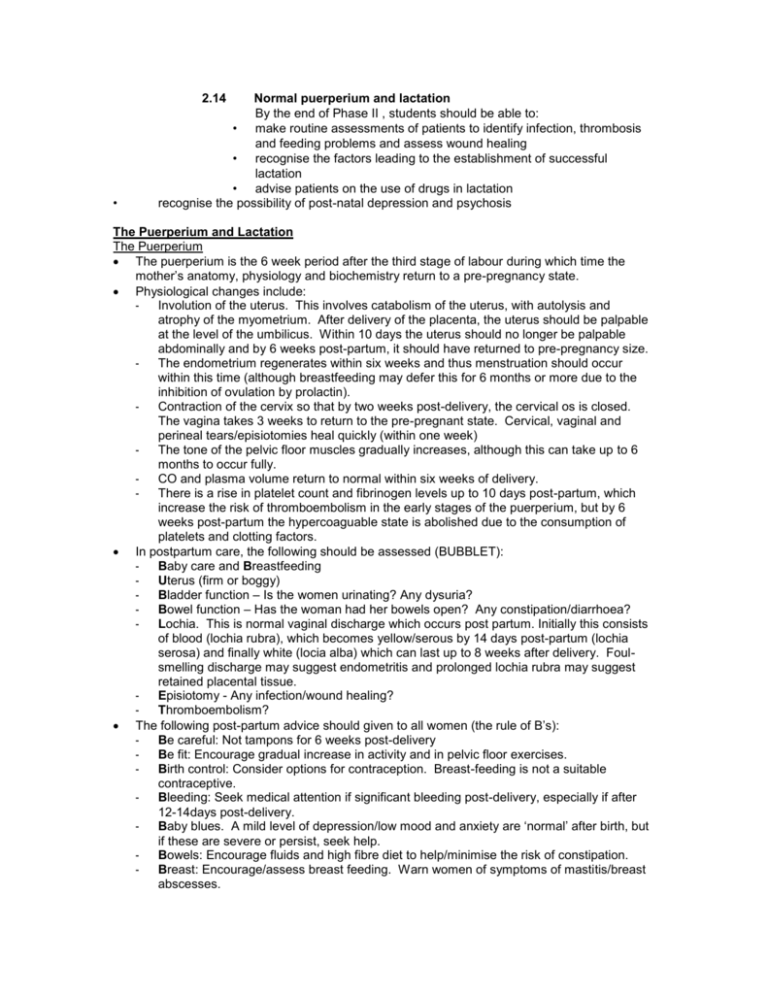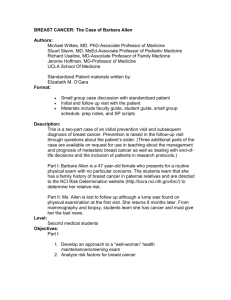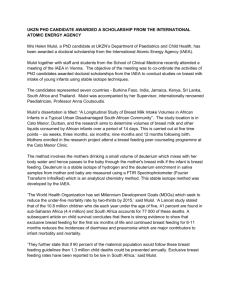Puerperium
advertisement

2.14 • Normal puerperium and lactation By the end of Phase II , students should be able to: • make routine assessments of patients to identify infection, thrombosis and feeding problems and assess wound healing • recognise the factors leading to the establishment of successful lactation • advise patients on the use of drugs in lactation recognise the possibility of post-natal depression and psychosis The Puerperium and Lactation The Puerperium The puerperium is the 6 week period after the third stage of labour during which time the mother’s anatomy, physiology and biochemistry return to a pre-pregnancy state. Physiological changes include: Involution of the uterus. This involves catabolism of the uterus, with autolysis and atrophy of the myometrium. After delivery of the placenta, the uterus should be palpable at the level of the umbilicus. Within 10 days the uterus should no longer be palpable abdominally and by 6 weeks post-partum, it should have returned to pre-pregnancy size. The endometrium regenerates within six weeks and thus menstruation should occur within this time (although breastfeeding may defer this for 6 months or more due to the inhibition of ovulation by prolactin). Contraction of the cervix so that by two weeks post-delivery, the cervical os is closed. The vagina takes 3 weeks to return to the pre-pregnant state. Cervical, vaginal and perineal tears/episiotomies heal quickly (within one week) The tone of the pelvic floor muscles gradually increases, although this can take up to 6 months to occur fully. CO and plasma volume return to normal within six weeks of delivery. There is a rise in platelet count and fibrinogen levels up to 10 days post-partum, which increase the risk of thromboembolism in the early stages of the puerperium, but by 6 weeks post-partum the hypercoaguable state is abolished due to the consumption of platelets and clotting factors. In postpartum care, the following should be assessed (BUBBLET): Baby care and Breastfeeding Uterus (firm or boggy) Bladder function – Is the women urinating? Any dysuria? Bowel function – Has the woman had her bowels open? Any constipation/diarrhoea? Lochia. This is normal vaginal discharge which occurs post partum. Initially this consists of blood (lochia rubra), which becomes yellow/serous by 14 days post-partum (lochia serosa) and finally white (locia alba) which can last up to 8 weeks after delivery. Foulsmelling discharge may suggest endometritis and prolonged lochia rubra may suggest retained placental tissue. Episiotomy - Any infection/wound healing? Thromboembolism? The following post-partum advice should given to all women (the rule of B’s): Be careful: Not tampons for 6 weeks post-delivery Be fit: Encourage gradual increase in activity and in pelvic floor exercises. Birth control: Consider options for contraception. Breast-feeding is not a suitable contraceptive. Bleeding: Seek medical attention if significant bleeding post-delivery, especially if after 12-14days post-delivery. Baby blues. A mild level of depression/low mood and anxiety are ‘normal’ after birth, but if these are severe or persist, seek help. Bowels: Encourage fluids and high fibre diet to help/minimise the risk of constipation. Breast: Encourage/assess breast feeding. Warn women of symptoms of mastitis/breast abscesses. Lactation and Breast-feeding During pregnancy, hPL, oestrogens and progesterone prepare the breast for milk production (by stimulating development of the mammary glands and ducts). When the baby suckles on the breast, there is release of two hormones from the pituitary: Prolactin (from the anterior pituitary) which stimulates milk production for the next feed. Oxytocin (posterior pituitary), which stimulates the ‘let-down’ reflex, where there is contraction of myoepithelial cells lining the alveolar ducts leading to release of milk from the breast. For the first week, colostrum is the substance produced by the breast, which has high protein, high Ig’s and high lymphocytes, with low levels of fat. Advantages of breast feeding are: Encourages bonding between mother and child No worry about sterilising bottles/warming the milk to the right temperature/getting the formulation wrong. Cheaper than bottle feeding Increased protection against infection in the baby (as there is IgA, lactoferrin and peroxidases within breast milk). Proteins in human breast milk are less likely to induce allergic reactions in the baby Breast feeding helps involution of the uterus and the high prolactin levels induce a contraceptive effect (although other forms of contraception should always be used). Reduced risk of breast and ovarian cancer in women who breast feed. Disadvantages of breast feeding are: Takes longer than bottle feeding Disrupts other activities Sore, cracked or bleeding nipples Mastitis/breast abscess Transmission of drugs/infection to the baby Breast feeding is contraindicated in: Premature babies (mum and baby are not prepared) Chronic maternal illness e.g. HIV, breast cancer, heart or renal disease Maternal drugs e.g. lithium, amiodarone, tetracyclines. Babies with abnormalities of the mouth e.g. cleft palate (may find it too hard to suckle). The child should be put to the breast as soon after delivery as possible. Suckling should be limited to 2-3 mins on each side and then this can be increased. The mother should be seated comfortably, ensuring the whole nipple is in the mouth. Most drugs are excreted in the breast milk to some degree. As a general rule, drugs which are not safe in pregnancy are not safe in breastfeeding. General advice includes: Use as few prescriptions drugs as possible Choose drugs with shorter half life’s Try to feed when the drug dose is lowest (e.g. just before the next dose is due) Choose routes which limit plasma concentration where possible (e.g. topical rather than oral steroids). As a general rule, drugs which are not safe in pregnancy are not safe in breastfeeding. Drugs to avoid in breastfeeding include: ACEI Amiodarone NSAID’s Statins Lithium Anti-psychotics unless absolutely necessary TCA’s SSRI’s Venlafaxine - Anti-fungals such as fluconazole Tetracyclines







